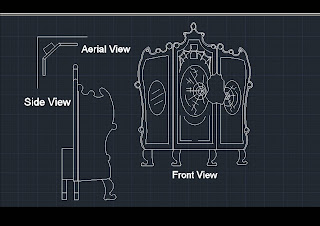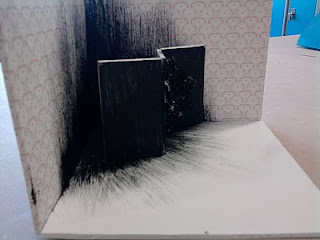








 In 1963 Robert Wise directed the cult thriller "The Haunting". A film that over the years has gained remarkable reputation with it's restrained technique of building up the tension and terror.
In 1963 Robert Wise directed the cult thriller "The Haunting". A film that over the years has gained remarkable reputation with it's restrained technique of building up the tension and terror. 
 shots to make the house appear tall and threatening there are other uses of camera shots to build the tension and terror. Very high angle shots are used to increase a sense of vertigo The still to the left is a prime example of this. The scene when the companion hangs herself at the top of the spiral stairs. The shot is well composed to allow only the bottom of the victims legs within the mise en scene and the sudden drop to the floor with nowhere to break the fall.
shots to make the house appear tall and threatening there are other uses of camera shots to build the tension and terror. Very high angle shots are used to increase a sense of vertigo The still to the left is a prime example of this. The scene when the companion hangs herself at the top of the spiral stairs. The shot is well composed to allow only the bottom of the victims legs within the mise en scene and the sudden drop to the floor with nowhere to break the fall. 
 very juvinille and innocent there is some debate over her mental stability. She needs stability and dependancy. Starting off by clinging closely to Theo. As she soon begins to believe that the house is focusing its attensions on her then her behaviour becomes even stranger. She goes from being a person who is looked over and taken for granted to the centre of importance. Her behaviour is very self centred and even endangers the others, for example when she is climbing the spiral staircase that is soon to collape she ignores Dr Markway's begs for her to come down and so he follows her in attempt of rescue. The end of the films sees Elenore sent away from the house for her own safty and against her own will, she wished to stay "forever" in this house that wants her and that she has beceome a part of. when driving away her car steers out of control into a tree. The audience questions whether the house took over the control of her car or infact it was Elenore who unknowingly tried to turn back to the house? whatever happened she succeeded as she now is part of the House's long and tragic history, she is one of those who walks alone within the silent walls
very juvinille and innocent there is some debate over her mental stability. She needs stability and dependancy. Starting off by clinging closely to Theo. As she soon begins to believe that the house is focusing its attensions on her then her behaviour becomes even stranger. She goes from being a person who is looked over and taken for granted to the centre of importance. Her behaviour is very self centred and even endangers the others, for example when she is climbing the spiral staircase that is soon to collape she ignores Dr Markway's begs for her to come down and so he follows her in attempt of rescue. The end of the films sees Elenore sent away from the house for her own safty and against her own will, she wished to stay "forever" in this house that wants her and that she has beceome a part of. when driving away her car steers out of control into a tree. The audience questions whether the house took over the control of her car or infact it was Elenore who unknowingly tried to turn back to the house? whatever happened she succeeded as she now is part of the House's long and tragic history, she is one of those who walks alone within the silent walls

Dimensions

Instructions




 Even though I had scaled out the heights and widths of the screen onto my garage door it still wasn't entirly clear so using large sheets of white cardboard I recreated the dimensions of the screen onto the card to see for sure if these measurements were appropriate.
Even though I had scaled out the heights and widths of the screen onto my garage door it still wasn't entirly clear so using large sheets of white cardboard I recreated the dimensions of the screen onto the card to see for sure if these measurements were appropriate.
I have made some decisions conserning the design which I thought would help the size of the room. Usually screens stand in a consateena shape so it will pretrude into the room like a zig zag. My screen sits closer into the corner (as behind the screen is not seen then this doesnt really matter) if the screen stands in a U shape into the corner (see aerial design on autocad drawing) this will give us more valuable furnature space. Plus this means the mirrors will be angled towards each section of the room facing Ivan's death sofa.
The highest point of the screen in 6ft tall but the rest purposfully slopes down to a shorter 4ft 7 to fit in with our restricted room area. (Behind the screen I will/ or whoever is constructing it will create a small box on the back with two more legs.) I know screens would not have had this but because it woud not be seen it wont really matter It is purely for stability the other legs will add stability but also removable weights can be added to the box to ensure the screen stands up. Because the weights and the box are removeable this will help with transporting the piece of furnature.
The auto cad drawing (front side and aerial views)

 ith the spread of Baroque and the arts and crafts movement signature pieces of furniture like this became part of the specific interior architecture. The screens seen around the time of Ivan Ilych varied from heavy dark wood panels, plain virtical 6ft panels or far more decorative panels that stand on small feet with beautiful undulating mouldings crowing the tops of the panels. Some of the screens though the basic structure was wood others had fabric or paper inlays to add to their grand appearance. Gold leaf was also a popular finish. Because this is a dressing screen my design will have mirrors upon the panels but because this sreen is in the corner of Ivan's room distorted by hylusination and fear the screen itself must be a dark twisted formation incorporating Rob's ideas of the burning hole through the centre and the black paint leaking through. I will also have to consider:
ith the spread of Baroque and the arts and crafts movement signature pieces of furniture like this became part of the specific interior architecture. The screens seen around the time of Ivan Ilych varied from heavy dark wood panels, plain virtical 6ft panels or far more decorative panels that stand on small feet with beautiful undulating mouldings crowing the tops of the panels. Some of the screens though the basic structure was wood others had fabric or paper inlays to add to their grand appearance. Gold leaf was also a popular finish. Because this is a dressing screen my design will have mirrors upon the panels but because this sreen is in the corner of Ivan's room distorted by hylusination and fear the screen itself must be a dark twisted formation incorporating Rob's ideas of the burning hole through the centre and the black paint leaking through. I will also have to consider: the materials
the materials

Some initial rough sketches of designs these will continue to develop. (the sketches are not up to my usual standard as I am recovering from a very horrible stomach virus)



 During the meeting with Andy, Colin and Simon each area of the room was discussed. In relation to our ideas it was concluded that there were several symbols that could be utilised to allude to the presence of a child, like a shoe or a toy/ trike... (sketch below) The use of the broken mirror was openly accepted but processes of construction were planned and Rhyan suggested using glass photographic transfers to print the facial reflection on the mirror?
During the meeting with Andy, Colin and Simon each area of the room was discussed. In relation to our ideas it was concluded that there were several symbols that could be utilised to allude to the presence of a child, like a shoe or a toy/ trike... (sketch below) The use of the broken mirror was openly accepted but processes of construction were planned and Rhyan suggested using glass photographic transfers to print the facial reflection on the mirror? After this presentation the group stayed behind to finalise the layout of the two rooms. This was done using a white board in order to regularly erase and alter ideas. Other members of the team held out a tape measure to give us some idea of how big the room will be. This was particularly useful for deciding on the size and position of the windows making sure they are equally spread and making enough room for larger pieces of furniture.
After this presentation the group stayed behind to finalise the layout of the two rooms. This was done using a white board in order to regularly erase and alter ideas. Other members of the team held out a tape measure to give us some idea of how big the room will be. This was particularly useful for deciding on the size and position of the windows making sure they are equally spread and making enough room for larger pieces of furniture.



 en a few times throughout the movie but ironically is is the last image seen in the film but of Trelkovsky in the same situation after his attempt at suicide. The bandaged face unnerves people because it is a lack of identity stripping the character of their recognisable features. The scream is a typical horror feature created to shock and strike fear into those watching (and listening)
en a few times throughout the movie but ironically is is the last image seen in the film but of Trelkovsky in the same situation after his attempt at suicide. The bandaged face unnerves people because it is a lack of identity stripping the character of their recognisable features. The scream is a typical horror feature created to shock and strike fear into those watching (and listening)